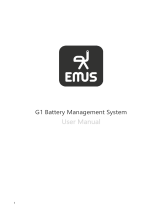Rozna ulica 20, 6230 Postojna, Slovenia
mail: info@rec-bms.com; www.rec-bms.com
5
System Overview:
Figure 3 shows the integration of the pre-charge unit in a typical 24 V battery power system, using REC
1Q BMS with an internal relay control. Only the connections relevant to the pre-charge unit operation
are shown. 15 Ω pre-charge output is used in conjunction with 24 V single coil power contactor. After
the battery pack is connected to SUPPLY + and SUPPLY GND internal pre-charge slowly charges the
input capacitor and powers the POWER red LED. Unit enters standby mode lowering its consumption
until the BMS input GND is pulled down to SUPPLY GND. Then the internal DIP switches are read (see
Table 4 for detail settings description). Single or double contactors may be used to connect the DC
link.
Single coil contactor/s
In case of single coil contactor/s DIP switch setting, the DC- (RESET COIL) is engaged first and pre-
charge transistor turns ON. When the pre-charge timeouts, SET coil is powered constantly ON to
enable DC+ connection and the pre-charge transistor inside the unit is turned OFF.
When the BMS input GND is released, DC+/SET COIL and DC-/RESET COIL are both turned OFF.
Bi-stable latching contactor
In case of a bi-stable latching relay DIP switch mode DC+/SET COIL is turned ON for a period of 100 ms
for engaging bi-stable latching relay. Then the pre-charge transistor inside the unit is turned OFF.
When the BMS input GND is released, DC-/RESET COIL is powered for 150 ms to turn the bi-stable
relay/contactor OFF.
Figures 3 - 7 show typical system integrations.
















